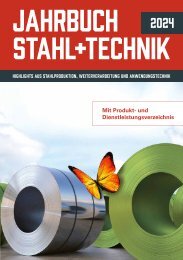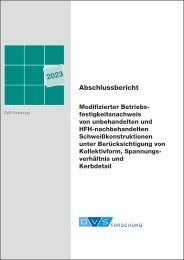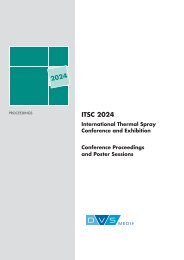STEEL + TECHNOLOGY 04/2019 EXTRACT
STEEL + TECHNOLOGY 04/2019 EXTRACT
STEEL + TECHNOLOGY 04/2019 EXTRACT
You also want an ePaper? Increase the reach of your titles
YUMPU automatically turns print PDFs into web optimized ePapers that Google loves.
<strong>STEEL</strong> <strong>TECHNOLOGY</strong> | 53<br />
ing of prototypes. Danieli Centro Combustion<br />
tested and refined ultra-low NO x burners<br />
(MAB and TFB) optimizing flame<br />
pattern, flexibility of fuel-gas feedstock,<br />
extremely low NO x emissions (particularly<br />
in the flameless configuration) and, for<br />
indirect combustion, high radiant-tube efficiency<br />
and temperature uniformity.<br />
Clean emulsion. In aluminum cold rolling,<br />
water-oil emulsions may replace kerosene-based<br />
lubricants, with increased<br />
safety and lower CapEx and OpEx, related<br />
to safety equipment and to the absorption/<br />
distillation recovery system (-10%). Lower<br />
emissions also may be expected because<br />
there are no kerosene vapors to treat.<br />
Zero fume. An effective design of the<br />
absorption and distillation processes can<br />
reduce VOC abatement for aluminum cold<br />
rolling. The choice of the most technologically<br />
advanced packing structures in the<br />
absorption column ensures maximum contact<br />
between vapors and the absorbent, to<br />
pick up the majority of VOCs with very low<br />
leakage through the fume plant. The distillation<br />
column that regenerates the absorption<br />
solution while recovering the rolling oil<br />
is designed with a combination of temperature<br />
and pressure that minimizes the degradation<br />
of the oil, which turns out to have<br />
a longer life. The internal recirculation in<br />
the distillation column acts as further protection<br />
for the oil, dampening the temperature<br />
peaks of the incoming solution.<br />
Low temperature rolling. Improved structural<br />
steel properties have been obtained<br />
mainly by:<br />
• restricting the carbon content;<br />
• improving the internal cleanliness; and,<br />
• using micro-alloyed grades combined<br />
with in-line thermomechanical processing.<br />
This last development makes it possible to<br />
refine the microstructure to produce<br />
stronger steels and to influence the<br />
time-temperature transformation of the<br />
steel to create a microstructure more suitable<br />
for heat treatment, thus reducing<br />
treatment time and therefore costs and<br />
footprint.<br />
Power and automation<br />
Q3-OPT. It increases plant yield, thus<br />
reducing energy demand. Upon definition<br />
of the objective functions and KPIs, the<br />
Figure 5. Q-ONE system with its installation was designed to ensure simple removal of<br />
the inverter and converter units, thus guaranteeing easy inspection and maintenance of<br />
the main components (Picture: Danieli)<br />
system quickly prompts and thoroughly<br />
reschedules the activities. The added value<br />
is the ability to manage complexity<br />
and to implement the most valuable<br />
know-how from experienced operators.<br />
An optimized plant, both in operation and<br />
in maintenance, minimizes the energy<br />
demand and the expended resources,<br />
increasing product quality and reducing<br />
wastes.<br />
Q3-DEMS. It is an energy and utility<br />
monitoring and utilization tool for collecting<br />
the widest range of information and<br />
it provides a simple interface to reprocess<br />
data into KPI, predefined or used<br />
defined. Everything is recorded and<br />
monitored in order to highlight irregular<br />
operations or time-changing performances.<br />
Q3-DEMS supports continuous<br />
improvement in energy efficiency,<br />
according to ISO50001:2011.<br />
Smart power. Based on inverters, assisted<br />
by an Adaptive Auto Pilot, combined<br />
with an advanced firmware and a high-efficiency<br />
induction motor, it eliminates the<br />
typical problems of a DC solution: low efficiency,<br />
high maintenance cost for the DC<br />
motor, low overload capability, network<br />
disturbances (harmonics and low power<br />
factor), etc. This technology delivers an<br />
innovative control strategy for energy savings,<br />
higher productivity, process flexibility,<br />
and reduced impact on the MV/LV distribution<br />
network.<br />
Data analysis. Modern sensors and a database<br />
of failure events changed the approach<br />
to maintenance from preventive to predictive.<br />
Scheduling algorithms are generated<br />
to plan maintenance, starting from analysis<br />
of current conditions and estimating<br />
remaining performance life. Stoppages can<br />
be reduced to a minimum and spare parts<br />
can be acquired only as needed, avoiding<br />
obsolescence and redundancy.<br />
Safety<br />
Robotics are key where highly accurate<br />
and repetitive processes are required, as<br />
well as where there is risk to personnel<br />
safety. For example, robots are effectively<br />
used on the furnace and casting floors, as<br />
well as to tend zinc pots for galvanizing<br />
lines, for deburring, tracking, and marking<br />
rolled products, and more where other<br />
repetitive tasks are required.<br />
“No man on the floor” is a strategic target<br />
and Q3-Pulpit technology is an example<br />
of current applications. 360° video<br />
cameras support operators with remote<br />
inspection capabilities. A database of critical<br />
events that require operators’ attention,<br />
constantly enriched through machine<br />
learning techniques, can activate some<br />
specific camera automatically to bring the<br />
event to the attention of the operator.<br />
Today, pulpits are ergonomic and interactive,<br />
with predefined operations already<br />
available and promptly activated.<br />
Personnel training. Greater skill is required<br />
to run modern plants and personnel training,<br />
together with self-learning and predictive<br />
technologies, assist operators in their<br />
choices, minimizing production issues and<br />
health hazards.<br />
Trained workers know how to operate and<br />
maintain a plant in optimal conditions. This<br />
leads to best performances and risk reduction.<br />
Environmental benefits come from minimizing<br />
energy and resource needs, and from<br />
avoiding major failures. Danieli Training<br />
Center transfers to employees the knowledge<br />
needed to operate plants and to maintain<br />
equipment and address safety issues.<br />
<strong>STEEL</strong> + <strong>TECHNOLOGY</strong> 1 (<strong>2019</strong>) No. 4


















